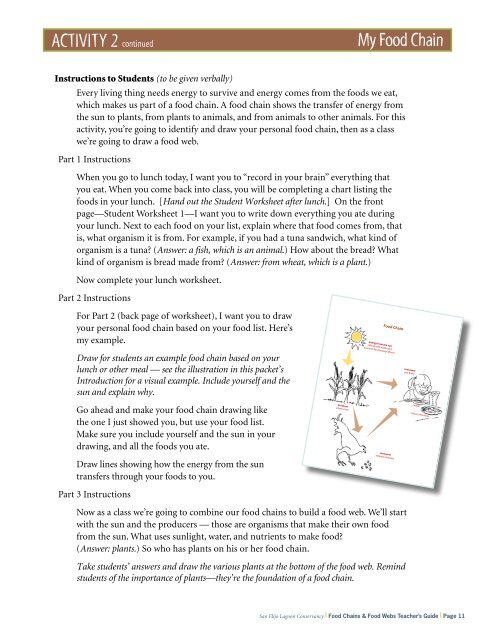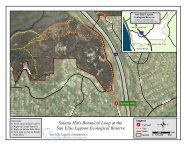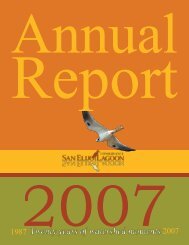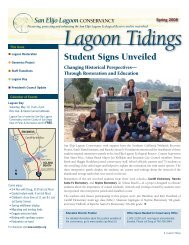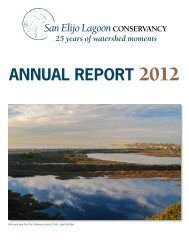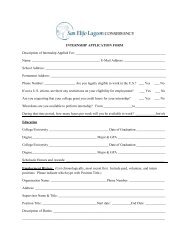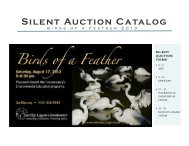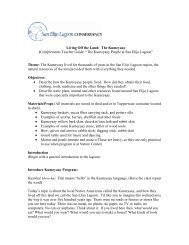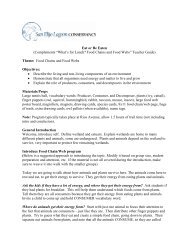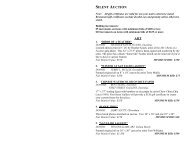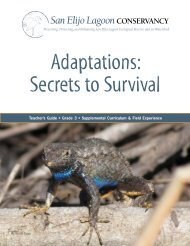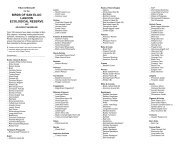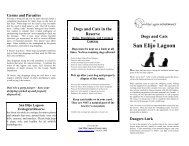Food Chains and Food Webs - San Elijo Lagoon Conservancy
Food Chains and Food Webs - San Elijo Lagoon Conservancy
Food Chains and Food Webs - San Elijo Lagoon Conservancy
Create successful ePaper yourself
Turn your PDF publications into a flip-book with our unique Google optimized e-Paper software.
ACTIVITY 2 continued<br />
My <strong>Food</strong> Chain<br />
Instructions to Students (to be given verbally)<br />
Every living thing needs energy to survive <strong>and</strong> energy comes from the foods we eat,<br />
which makes us part of a food chain. A food chain shows the transfer of energy from<br />
the sun to plants, from plants to animals, <strong>and</strong> from animals to other animals. For this<br />
activity, you’re going to identify <strong>and</strong> draw your personal food chain, then as a class<br />
we’re going to draw a food web.<br />
Part 1 Instructions<br />
When you go to lunch today, I want you to “record in your brain” everything that<br />
you eat. When you come back into class, you will be completing a chart listing the<br />
foods in your lunch. [H<strong>and</strong> out the Student Worksheet after lunch.] On the front<br />
page—Student Worksheet 1—I want you to write down everything you ate during<br />
your lunch. Next to each food on your list, explain where that food comes from, that<br />
is, what organism it is from. For example, if you had a tuna s<strong>and</strong>wich, what kind of<br />
organism is a tuna? (Answer: a fish, which is an animal.) How about the bread? What<br />
kind of organism is bread made from? (Answer: from wheat, which is a plant.)<br />
Now complete your lunch worksheet.<br />
Part 2 Instructions<br />
For Part 2 (back page of worksheet), I want you to draw<br />
your personal food chain based on your food list. Here’s<br />
my example.<br />
Draw for students an example food chain based on your<br />
lunch or other meal — see the illustration in this packet’s<br />
Introduction for a visual example. Include yourself <strong>and</strong> the<br />
sun <strong>and</strong> explain why.<br />
Go ahead <strong>and</strong> make your food chain drawing like<br />
the one I just showed you, but use your food list.<br />
Make sure you include yourself <strong>and</strong> the sun in your<br />
drawing, <strong>and</strong> all the foods you ate.<br />
Draw lines showing how the energy from the sun<br />
transfers through your foods to you.<br />
Part 3 Instructions<br />
producer<br />
plant (corn)<br />
<strong>Food</strong> Chain<br />
energy from the sun<br />
(along with water <strong>and</strong><br />
nutrients for photosynthesis)<br />
consumer<br />
animals (chicken)<br />
Now as a class we’re going to combine our food chains to build a food web. We’ll start<br />
with the sun <strong>and</strong> the producers — those are organisms that make their own food<br />
from the sun. What uses sunlight, water, <strong>and</strong> nutrients to make food?<br />
(Answer: plants.) So who has plants on his or her food chain.<br />
Take students’ answers <strong>and</strong> draw the various plants at the bottom of the food web. Remind<br />
students of the importance of plants—they’re the foundation of a food chain.<br />
consumer<br />
you & me<br />
cereal<br />
huevos rancheros<br />
<strong>San</strong> <strong>Elijo</strong> <strong>Lagoon</strong> <strong>Conservancy</strong> | <strong>Food</strong> <strong>Chains</strong> & <strong>Food</strong> <strong>Webs</strong> Teacher’s Guide | Page 11


